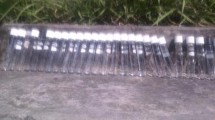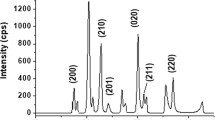Abstract
Silica gel-supported Fe(II) (SiOFe) was prepared and used for heterogeneous degradation of sulforhodamine B (SRB) and 2,4-dichlorophenol (DCP) under visible irradiation (λ > 420 nm) as an effective catalyst. UV-visible spectra, and infrared Spectrophotometry (IR), fluorescence, total organic carbon (TOC) and electron spin resonance (ESR) measurements were employed to analyze the photoreaction products. The results showed that SRB could be efficiently degraded by SiOFe/H2O2 system under visible irradiation with 100% decolorization and 72.3% TOC removal after 180 min illumination. The results of ESR and fluorescence measurements indicated that the oxidative process was predominated mainly by the hydroxyl radical (·OH) generated in the system.
Similar content being viewed by others
References
Lipczynska-Kochany E. Degradation of aqueous nitrophenols and nitrobenzene by means of the Fenton reaction. Chemosphere, 1991, 22: 529–536
Solozhenko E G, Soboleva N M, Goncharnk V V. Decolourization of azo dye solution by Fenton oxidation. Wat Res, 1995, 29: 2206–2210
Dai Q H, Chen S, Li Y X. Carcinogenesis of asbestos switched on by induing cross-linkage between DNA complementary pair bases. Chin Sci Bull, 2002, 47: 1086–1081
Fernandez J, Bandara J, Lopez A, et al. Photoassisted Fenton degradation of nonbiodegradable azo dye (Orange II) in Fe-free solutions mediated by cation transfer membranes. Langmuir, 1999, 15: 185–192
Feng J, Hu X, Yue P. Novel bentonite clay-based Fe-nanocomposite as a heterogeneous catalyst for photo-Fenton discoloration and mineralization of orange II. Environ Sci Technol, 2004, 38: 269–275
Wu K, Zhang T, Zhao J, et al. Photodegradation of a dye in the presence of Fe3+/H2O2 under visible light irradiation. Chem Lett, 1998, 6: 857–858
Entezari M, Heshmati A, Sarafraz-yazdi A. A combination of ultrasound and inorganic catalyst:removal of 2-chlorophenol from aqueous solution. Ultrason Sonochem, 2005, 12: 137–141
Minero C, Lucchiari M, Vione D, et al. Fe(III)-enhanced sonochemical degradation of methylene blue in aqueous solution. Environ Sci Technol, 2005, 39: 8936–8942
Brillas E, Casado J. Aniline degradation by Electro-Fenton and peroxi-coagulation processes using a flow reactor for wastewater treatment. Chemosphere, 2002, 47: 241–248
Oturan M A, Oturan N, Lahitte C, et al. Production of hydroxyl radicals by electrochemically assisted Fenton’s reagent: Application to the mineralization of an organic micropollutant, pentachlorophenol. J Electroanal Chem, 2001, 507: 96–102
Cheng M, Ma W, Li J, et al. Visible-light-assisted in the presence of H2O2 at neutral pH values. J Environ Sci Technol, 2004, 38: 1569–1575
Cheng M, Sun Z, Ma W, et al. Efficient degradation of dye pollutants using dioxygen mediated by iron(II) 2,2′-bipyridine loaded layered clay catalyst under visible irradiation. Sci China Ser B-Chem, 2006, 49: 407–410
Li J, Ma W, Huang Y, et al. A highly selective photoxidation approach using O2 in water catalyzed by iron(II) bipyridine complex supported on NaY Zeolite. Chem Comm, 2003, 2214–2215
Neamtru M, Zaharia C, Catrinescu C, et al. Fe-exchanged Y zeolite as catalyst for wet peroxide oxidation of reactive azo dye procion Marine H-EXL. Appl Catal B-Environ, 2004, 48: 287–294
Li Y, Lu Y, Zhu X. Photo-Fenton discoloration of the azo dye X-3B over pillared bentonites containing iron. J Hazard Mater B, 2006, 132: 196–201
Molina C B, Casas J A, Zazo J A, et al. A comparison of Al-Fe and Zr-Fe pillared clays for catalytic wet peroxide oxidation. Chem Engine J, 2006, 118: 29–35
Dhananjeyan M R, Mielzcarski E, Thampi K R, et al. Photodynamics and surface characterization of TiO2 and Fe2O3 photocatalysts immobilized on modified polyethylene films. J Phys Chem B, 2001, 105: 12046–12055
Gumy D, FernándezIbáňez P, Malato S, et al. Supported Fe/C and Fe/Nafion/C catalysts for the photo-Fenton degradation of Orange II under solar irradiation. Catal Today, 2005, 101: 375–382
Zheng Z, Lei L. Immobilization of Fe2+ in UV/Fenton systems and the catalytic reaction of the system. Chin J Chem Eng, 2004, 18: 739–744
Clescerl S L, Greenberg A E, Eaton A D. Standard Methods for the Examination of Water and Wastewater. 20th ed. Washington DC: American public Health Association/American Water Works Association/Water Environment Federation, 2000
Munaf E, Zein R, Kurniadi I. The use of rice husk for removal of phenol from wastewater as studied using 4-aminoantipyrine spectrophotometric method. Environ Sci Technol, 1997, 18: 355–358
Zepp R G, Faust B C, Hoigne J. Hydroxyl radical formation in aqueous reaction(pH 3–8) of iron(II) with hydrogen peroxide: The photo-Fenton reaction. Environ Sci Technol, 1992, 26: 313–319
Baker M S, Cebiki J M. The effect of pH on the conversion of superoxide to hydroxyl free radicals. Arch Biochem Biophys, 1984, 234: 258–264
Mchedlov N O, Shapovalov S A, Egorova S I, et al. A new application of Rhodamine 200B (sulfo rhodamine B). Dyes Pigments, 1995, 28: 7–18
Huang Y, Ma W, Li J, et al. Efficient H2O2 oxidation of organic pollutants catalyzed by supported iron sulfophenylporphorin under visible light irradiation. J Phys Chem B, 2004, 108: 7263–7270
Huang Y, Ma W, Zhao J, et al. A novel β-CD-hemin Complex photo-catalyst for efficient degradation of organic pollutants at neutral pHs under visible irradiation. J Phys Chem B, 2003, 107: 9409–9414
Ma W, Huang Y, Li J, et al. An efficient approach for photodegradation of organic pollutants by immobilized iron ions at neutral pHs. Chem Comm, 2003, 1582–1583
Author information
Authors and Affiliations
Corresponding author
Additional information
Supported by the National Natural Science Foundation of China (Grant Nos. 50639070 and 20373074), the Youth Outstanding Foundation of Hubei Province of China (Grant No. 2005ABB030) and the Natural Science Research Plan Project of Education Office of Hubei Province of China (Grant No. 2004Z001)
About this article
Cite this article
Zhao, C., Huang, Y., Fang, Y. et al. Visible light-induced degradation of organic pollutants using Fe(II) supported on silica gel as an effective catalyst. Chin. Sci. Bull. 53, 1497–1502 (2008). https://doi.org/10.1007/s11434-007-0524-2
Received:
Accepted:
Published:
Issue Date:
DOI: https://doi.org/10.1007/s11434-007-0524-2




